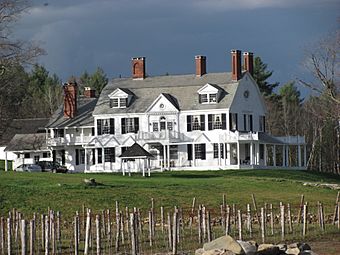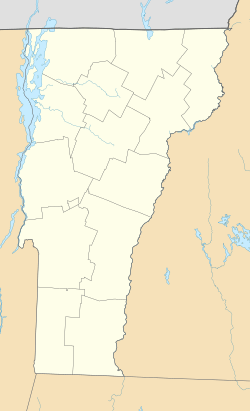Brook Farm (Cavendish, Vermont) facts for kids
Quick facts for kids |
|
|
Brook Farm
|
|
 |
|
| Location | 4203 Twenty Mile Stream Rd., Cavendish, Vermont |
|---|---|
| Area | 23 acres (9.3 ha) |
| Built | 1894 |
| Architectural style | Colonial Revival |
| MPS | Agricultural Resources of Vermont MPS |
| NRHP reference No. | 93000676 |
| Added to NRHP | July 22, 1993 |
Brook Farm is a special old farm estate in Cavendish, Vermont. It has a very grand house built in 1894. The farm also has other buildings from when it was a "model farm" around the year 1900.
A model farm was a farm that showed off the best and newest farming methods. Brook Farm was added to the National Register of Historic Places in 1993. Today, it is known as the Brook Farm Vineyard, where grapes are grown for wine.
Contents
What is Brook Farm Like?
Brook Farm covers about 45 acres (18 hectares) in a quiet part of Cavendish. The farm buildings are on the west side of Twenty Mile Stream Road. The land has rolling fields and stone walls, and it looks out over Twenty Mile Stream.
The Main House
The main house is very large, with two and a half stories. It is made of wood and sits on a stone foundation. The house has a big porch that wraps around three sides. This porch has open areas and balconies. The inside of the house is fancy, with lots of nice wood and decorated ceilings.
Other Buildings
Most of the farm buildings are set up in a curve. The main house, a horse stable, and a cow barn are the biggest buildings. There are about ten buildings in total. These buildings show what a successful farm looked like a long time ago.
A Farm's History
Farming started on this land way back in 1788. Over the 1800s, it became one of the biggest and best dairy farms in Cavendish. A dairy farm is where cows are raised for milk.
James H. Bates and the Model Farm
In 1881, a businessman named James H. Bates bought the farm. He was from Brooklyn, New York and Kalamazoo, Michigan. Mr. Bates wanted to make Brook Farm a "model farm." This meant it would use the newest and best farming ideas.
He moved the old farm buildings to build the grand house you see today. An architect named Clinton Smith helped design the house. It was finished in 1894. Many of the other farm buildings were also built around this time. The original barn from 1790 was part of Mr. Bates's plan, but it fell down in 1988.
Today, Brook Farm is a vineyard, growing grapes instead of dairy products.
Images for kids




